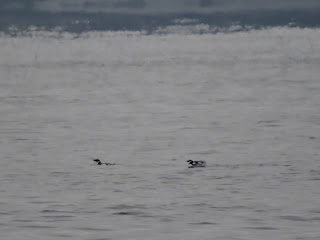The wetter weather has, for the most part, kept me from spending time outdoors (as has studying flora, biogeoclimatic ecological classification, interviews and christmas preparations) but I did participate in 2 christmas bird counts this week.
The Nanoose CBC (held Friday December 18th) was not the most productive with only 22 species being observed. Low numbers were expected as the route our group birded was along logging roads in areas of active logging. We were able to drive up to 440m in elevation where we were pleased to find a Gray Jay (the only one for the count). I was informed (and have not yet confirmed) that forestry only pays for timber hauled out, and not what is cut. Sadly, these clear cut areas had many felled trees that have clearly been left behind. Hopefully over the years these downed trees will provide the soil with nutrients for new growth. Personally I feel the forestry industry should be held accountable for all that is cut, not just what is hauled out!
It would appear that the trees in the higher elevations (possibly Mountain Hemlock Ecozone) are either not reachable by foresters, or not profitable to invest in harvesting.
The Parksville CBC (held Sunday December 20th) was significantly more productive than the Nanoose CBC for me. With 72 species observed, and some impressive numbers of pacific loon (600+) and western grebe (30), it was clear that the ocean is where the action is! Numbers for scoters was lower than previous years and some dirt birds were also not discovered by our group (rock pigeon and house sparrow for example), but compared to Friday this was very "birdy".
Snow covered mountainous ridges (with clear cutting beneath)
Black Scoter
Surf Scoter
River Otter enjoying some Sculpin sp
Merlin perched near the blueberry farms.
























































